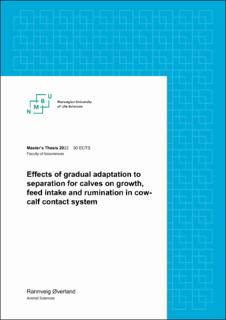| dc.description.abstract | As animal welfare concerns are increasing, so is the interest in cow-calf contact (CCC). In CCC, the cow and calf go together for an extended period in dairy production. Compared to normal practice were the calf are separated from the cow within a few hours after birth. Producers practicing CCC have seen lower milk yields but also higher calf growth. In this study, two separation strategies for adaptation to the separation of cow and calf were explored in a cow-driven system. Both strategies had four phases at different intervals: 24 hours of accessibility (phase 1), 12 hours (phase 2), 6 hours (phase 3), and 0 hours (phase 4) at the age of 8 weeks, but fence line contact, at the age of 9 weeks they were totally weaned. The long adaptation started at the age of 4 weeks and comprised of 28 days and the short starts at the age of 6.5 weeks and comprised of 10 days. The adaptation happened in a specially designed area that was divided into three different areas: cow area, calf creep, and meeting area. In the calf creep the calves had access to concentrate, water, and roughage, and after phase 2 started also a milk feeder. The calves were weighed two times a week after the move into the special designed area. Roughage intake were measured two times a week over a 24 h interval, while the intake of concentrate and milk form the feeder were measured each time the calves visited the feeder. Rumination was measured by a Nedap neck collar device that were placed on the calf neck as they were dehorned. In this study, there was no significant difference between the adaptation strategies, even though there is a potential. The daily growth was 1.2 kg/d which is higher than current recommendations and the calves weighed on average 100 kg at 9 weeks of age. Intake of roughage, concentrate and water, as well as rumination were not significantly different between the strategies. Ad libitum access to milk did influence the intake of solid feeds, which were lower than for calves fed restricted. | en_US |

